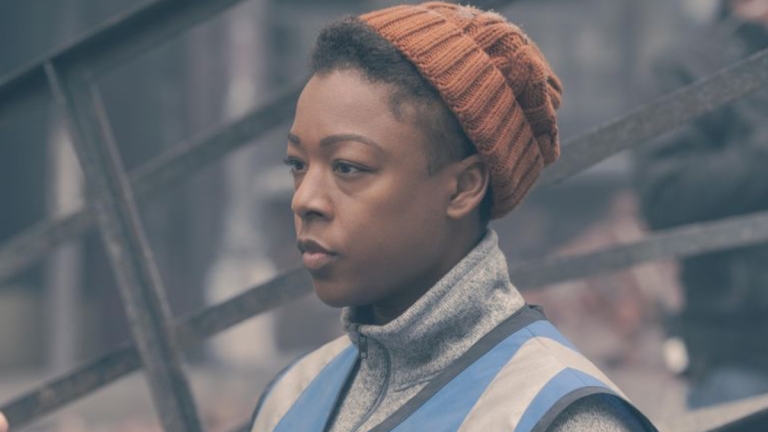On this season of The Handmaid’s Tale, understatement really isn’t an option. The emotional intensity of this episode and the ones before it has been deafeningly high. Every decision is literally a matter of life or death, every statement is forceful, every encounter is emotional and urgent. Elisabeth Moss, Samira Wiley, and the others are fortunate to be able to maintain this degree of prolonged tension because melodrama may easily result from high drama with a weaker cast or untrained direction.
This episode’s force might have been too much to handle if pre-Gilead flashbacks hadn’t been used as tension-relieving mechanisms. That has always been this show’s natural environment: teetering on the brink of being too much to handle yet still managing to maintain equilibrium. This balance was supplied by the sequences in which June, Moira, and Luke were in their early 20s and negotiating the adjustments that their imminent marriage to Luke and June entailed. They provided some calm in an otherwise tense episode and brought June’s present-day regret about leaving Hannah behind in Gilead into sharp relief with her earlier anxiety about disappointing Luke.
Find a better rom-com line than author Dorothy Fortenberry’s: “What if I’m not who you think I am?” / “Then I’ll just adore whatever you turn out to be.” The flashbacks also worked to heighten June and Luke’s reunion by reminding viewers how their relationship used to be. In The Handmaid’s Tale, flashbacks frequently serve to contrast with the present and highlight the gap between it and the past. The opposite occurred when Luke and June went back to their first love. Our understanding of the couple we observed melt into one another on that cruise was strengthened by witnessing June’s excitement upon receiving a phone call from (supposedly) Luke or his joy when they learned they were expecting a baby. When Luke entered the room, Moss and O.T. Fagbenle had a wonderful, wordless discussion with their eyes.
The show had long since broken free from Gilead’s symmetrical repetition, and the aid ship was yet another fresh backdrop in a season that has provided plenty of location variety. Similar to the prison in episode three, “The Crossing,” practically the whole episode took place on board, which intensified the suspense and emotional impact, particularly after night fell and sequences had to be shot in near complete darkness. The ship represented safety after the pandemonium of refugees that felt real at the port—for about 30 seconds—which is approximately how long The Handmaid’s Tale ever allows viewers to take a break and unwind. After that, the Guardian inspection was announced, and the subsequent countdown started.
After Oona (Zawe Ashton) informed Moira that she wasn’t permitted to bring June with them, that presented the second challenge. That was a winding blow. Since June and Moira’s reunion had been anticipated for so long, when it finally occurred at the conclusion of “Chicago,” it seemed to be the conclusion in and of itself. It seemed outrageously unfair that international law and bureaucracy might put a stop to it. But June being saved was the actual egregious injustice, as this episode was keen to point out.
The Trolley Problem, a classic ethical thought experiment that questions if one life is worth more than many, was presented as part of the “Vows” episode of The Handmaid’s Tale. June Osborne has such a strong hold on Moira and the audience that it was difficult to let her go. Oona and her companion are in the other corner. They are aware that saving Gilead’s No. 1 opponent would put the group in violation of the law, endanger future relief missions, and damage diplomatic ties. Unexpectedly, traumatised June sided with the other. At first, June’s willingness to turn herself in on the grounds that her life “isn’t worth more than anyone else’s” seemed overly heroic and selfless, turning our main character into a role model. Then she revealed that shame, not purity, lay beneath her act of self-sacrifice.
Due to her sorrow about failing to save Hannah and the still-missing-but-presumed-dead Janine, June didn’t feel deserving of rescue. June went into a tailspin when she realised she might make it to Canada and meet up with Luke again. She was unable to face him. How was she ever forgiven by him? not just for Hannah, but also for having a second love and abandoning Luke with his child for Nichole to raise? The cassette tape on which June described her devoted love with Nick was the last thing Luke heard from her.
The emotional motivator of this episode, and possibly the entire season, was guilt. June tells Moira that she feels like a bad mother and that she is to blame for everything that has happened to Hannah. In order to get June home, Moira had to put her friendship with Oona on the line due to her survivor guilt for leaving while June was still in Gilead. As Gilead’s victims internalised their shame, as survivors frequently do, the “your responsibility, your fault” buck of guilt transferred between June and Aunt Lydia in “The Crossing” reverberated throughout this episode.
This emotionally charged episode came to a close with June finally setting foot on Canadian soil, which was commemorated by director Richard Shepard using June Osborne’s iconic pose: dead centre of the frame, facing the camera. June’s eyes are typically fixated on the viewer in these photos as a promise of resistance to some heinous atrocity. They observed a convoluted homecoming this time. Is June’s battle with Gilead finally over now that she has left?
In the US, Hulu is currently streaming season four of The Handmaid’s Tale. Channel 4 in the UK is screening episodes of Season 4 every Sunday at 9 p.m.


